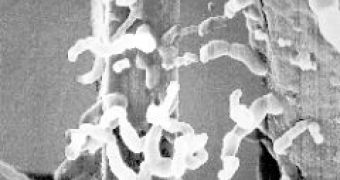The smallest creatures on our planet are called nanobes; they are microscopic things with such a reduced size that it almost violates the minimum requirements of the biological laws for the existence of independent life.
The nanobes were discovered few years ago in the oceanic underground by Dr. Phillipa Uwins, from Queensland University (Australia) during an oil drill. Watched at electronic microscope, the nanobes appear like thickets of filaments, similar to a fungus's mycelium, with a length of 20 to 150 nanometers (the millionth parts of a meter).
They are almost a thousand times smaller than the smallest cells in our body and ten times smaller than the smallest known bacterium. This is the size of a single ribosome (site of protein synthesis) or that of a virus, but most biologists consider that viruses do not possess their own life, because they need a host cell in order to reproduce.
When first discovered, there was a vivid discussion if the nanobes were living things or not. The tests showed the nanobes fulfilled the criteria to qualify as life: their colonies grew spontaneously; they contained genetic material (DNA); they were composed of organic molecules containing carbon, oxygen and nitrogen and an ultrathin section showed an outer layer or membrane that could represent a cell wall, surrounding a possible cytoplasm and nuclear area.
Their discovery has totally changed our thinking about the origins of life, and has given new strength to the theory that "micro-fossils" found by NASA in a Martian meteorite were evidence of primitive life forms. Up till now, critics have argued they couldn't have been bacteria, on the grounds that there were no living examples of nano-sized cells on earth, but now science has the clear-cut proof.
Other theories, that nano-bacteria may be responsible for kidney stones and be involved in processes such as rusting and the greening of copper, which have been rather rejected, must be now taken more seriously. Amazingly, the nanobes most likely came from a sandstone rock sample retrieved from 3-5km below the ocean bed, where the pressure is around 2,000 atmospheres and the temperature ranges from 115-170?C. "They are very tough structures," said Dr Uwins.
"Usually, if you're going to process a biological specimen for a scanning electron microscope, you put it through fixation and dehydration to maintain its structure, but the nanobes will go in and out of microscopes and withstand the vacuum and the electron beam and the X-rays. This is where the debate comes in over the Martian mineralized bacteria, because it suggests they can withstand space travel."

 14 DAY TRIAL //
14 DAY TRIAL //